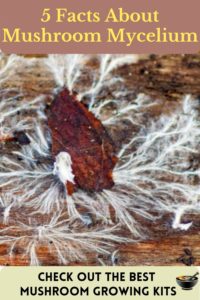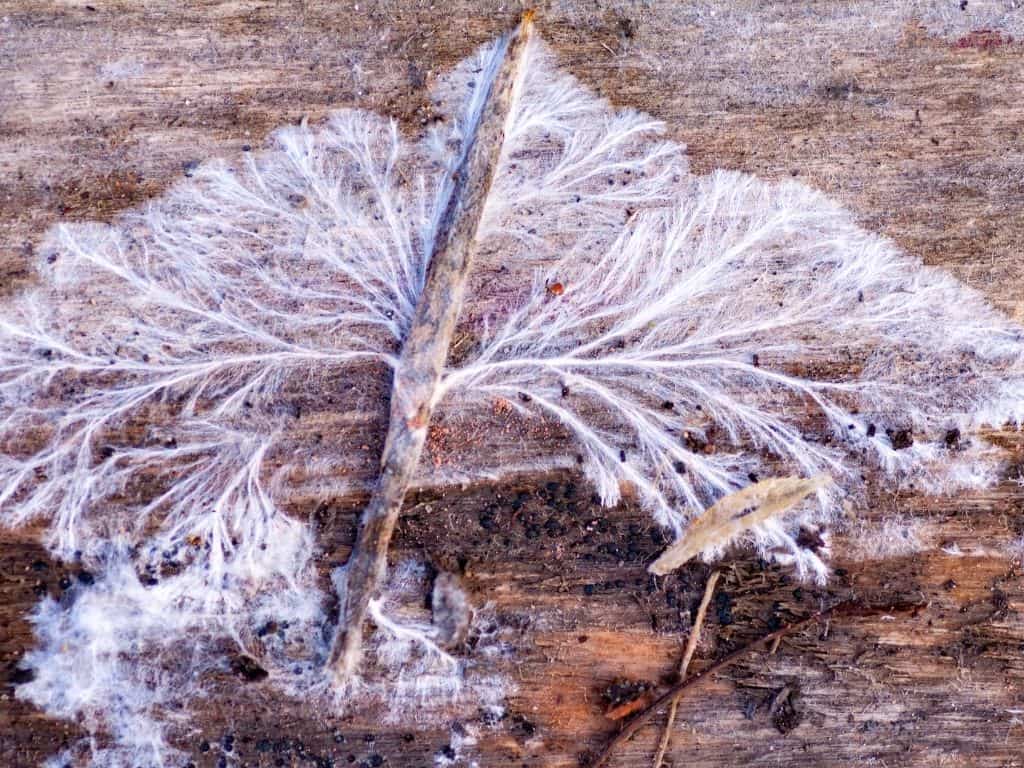What is mushroom mycelium?
Any mushroom lover needs to understand mushroom mycelium to truly understand fungus.
Mycelium is the living or vegetative part of the mushroom. It consists of a mass of branches that form fruiting bodies that become mushrooms.
Mycelium may be extremely small, creating a colony that’s too small to see. Mycelium can also create massive sized mushrooms, like the Armillaria, a genus that forms some of the largest living organisms in the world. The largest known organism covers several miles in Oregon and is thousands of years old.
Mycelium produces the vegetative or edible parts of fungi and also decomposes organic matter, giving it an important role in nature.
Now you know what mycelium is, so let’s explore it further with 5 facts about mushroom mycelium.
1. Why Mycelium Is Important In Mushroom Growth
Mycelium is vital to the creation of mushrooms. That’s because they are not only on the surface of the substance on which they are growing (soil or other matter) but also spread under the ground. By doing so, they can access the nutrients necessary to create growth of fungus, the fruiting bodies of fungi known as mushrooms.
That means mycelium’s network of fungal threads can spread as far as there are nutrients available, getting the nutrients needed from the soil or other substance and allowing the connected mushrooms to further grow and develop. That underground mycelium consists of a mass of single-cell strands called hyphae. The mushroom itself is the fruiting body of that fungus that disperses spores and creates even more mushrooms.
It’s also interesting to note that mycelium releases different types of enzymes, helping to break down complex materials into simpler matter, allowing the mycelium to more easily absorb what it needs. Mycelium also grows toward water or moist areas, so it can have the water needed for its development.
Mycelium is also important for the ecosystem, since it breaks down organic material to make it available again for use. Plants interact with fungi in a type of symbiosis, and mycelium will improve the condition of the soil for growing too. Mycelium provides a food source for insects and can also break down toxic substances like pesticides.
So if you’re wondering: What conditions are needed for mushrooms to grow? Mycelium needs substrate, or the material onto which it and mushrooms grow, such as rotting tree trunks, straw, cardboard or other matter.
2. Interesting Facts About Mushroom Mycelium
A common question often arises: Is mushroom mycelium healthy? In fact, mushroom mycelium and fermented substrate support immune health. A recent peer-reviewed study suggests that the filament-like roots in mushroom as well as the layer it’s grown on offer immune-enhancing benefits.
That certainly confirms the fact that mushrooms have multiple health benefits, with mycelium being the building blocks of its growth.
But mycelium can do so much more, as researchers are finding out.
As described in Scientific American, mycelium is similar to yeast. This fungi allows fermentation – a molecular process in which living cells transform sugar or starch into more complex molecules or chemicals. Liquid fermentation has given us beer and bread, for instance.
In recent years, exploration into the concept of liquid fermentation has also given us medicines like biosynthetic insulin. Single-celled bacteria and yeast can be used to synthesize other compounds, like bio-based fuels or life-saving drugs.
The difference with mycelium is that it is multicellular. It can grow into macro-size structures (mushrooms), or humans can intervene before a mushroom grows and use the mycelium instead to build structures by controlling temperature and other factors.
Companies are now exploring these uses for mycelium. Packaging material made from mycelium, for instance, is biodegradable, making it a great replacement for plastic or styrofoam. Here are a few other examples.
MycoWorks: This biotechnology company in San Francisco works with mycelium to create Fine Mycelium™, a patented process that engineers materials used in fashion and footwear. For instance, their flagship product known as Reishi™ is a natural material that compares to cowhide and other animal leathers when it comes to strength and durability. Reishi is custom-grown to their performance standards.
Ecovative Design: This company also uses mycelium in its technology to grow advanced materials. As the root structure of mushrooms, mycelium is capable of building macrostructures, and they are using it to create plant-based meat, biodegradable packaging, and leather-like textiles.
3. Preparation And Storage Of Mushroom Mycelium
If you’re planning to grow mushrooms, you may want to start with a mushroom growing kit, or purchase inoculated substrate, which means the material has already been injected with mushroom spawn.
If you want to start your own mycelium, you can prepare a substrate and experiment with your own development.
Here’s one example.
Place a layer of cardboard that’s been soaked in water into a small glass container. Slice the bottom part of a mushroom onto the cardboard. The base of the mushroom is where the mycelium will reproduce. Place another layer of wet cardboard, and more sliced mushroom base.
Close the container and put it in a dark room, opening the box once a day to let air out and fresh air in. You should soon see mycelium growing through the cardboard.
As for storing your mycelium prior to fruiting, it’s worth investigating the proper preparation and storage of the specific variety of mushroom you plan to cultivate.
Generally, you want to preserve the mycelium culture in a viable form. This is most commonly done in a culture tube or similar container and kept for a short period of time at room temperature, or in a refrigerator if storage is beyond 1-2 months.
Studies have looked at various ways of preserving cultures, including storage on sorghum grain at low temperatures (41-46 degrees Fahrenheit). The results were positive, in that the mushroom cultures were stored free from contamination for more than a year, and there wasn’t any growth or change to the culture. Another study looked at storing fungus in liquid nitrogen.
And if you wonder: Can mycelium die? The answer is yes. High temperatures for several hours, such as those over 85 degrees, can kill the mycelium. Cooler temperatures, like those below 55 degrees Fahrenheit, simply stop the fruiting of the mushrooms. And temperatures that are too cold for long periods of time can also kill the mycelium.
4. Best Growing Kits That Utilize It
There are a variety of ways you can grow mushrooms using mycelium, but the easiest is to purchase a growing kit that utilizes mycelium and will get you cultivating mushrooms quickly.
Here are a few examples:
Reishi Mycelium: Get 4 ounces of Yellow Reishi mushroom spawn mycelium, and then grow it on the substrate of your choice, such as straw or sawdust blocks.
Pearl Oyster Mycelium: 3.5 ounces of Pearl Oyster mushroom spawn mycelium, once again that you grow on the substrate of your choice.
Back to the Roots Organic Mini Mushroom Grow Kit: A great option for the beginner, so you can learn about the process of growing mushrooms. This simple-to-use kit will fruit Oyster mushrooms in just 10 days. Simply cut slits in the box and mist the kit daily.
Spawn and Wax Combo: If you have access to fallen trees and logs in your yard, and the patience to wait for your mushrooms to fruit, this is a good option. You get 100 Shiitake mushroom mycelium plugs with spawn, which you inject into hardwood logs or stumps. A detailed instruction pamphlet will help you figure it out, and your first fruiting mushrooms will appear from 6 to 15 months from inoculation, depending on the type of wood.
Boomr Bag: If you simply need substrate and would like to add your own culture, then the Boomr Bag is for you. It is 5 pounds of a sterile, manure-based bulk substrate blend to which you add and grow the mushroom of your choice.
5. Types Of Mushroom Mycelium
The strands that make up mycelium are called hyphae. As for the types of mycelium, there are two main types:
1. Septate: which have discrete cells called septa.
2. Coenocytic: which have a tubular network instead of septa, although septa may be present.
The hyphae bundle together to form the mycelia (the plural of mycelium), which looks fluffy or cotton-like. Mycelia cords are linear, parallel hyphae that look like plant roots, so they are also called rhizomorphs.
The mycelia get nutrients by absorption, gathering the nutrients needed from the substrate and absorbing through the cell walls. If the food is not soluble, the mycelia “digest” the nutrients by releasing enzymes. Depending on the substrate, specific enzymes break down the material into soluble matter that the mycelium can then absorb.
Sometimes people ask: Can you eat mushroom mycelium? The short answer is no. Raw, living mycelium should not be ingested. Many of the fruiting bodies, or mushrooms, are best eaten cooked too. In some instances, heating mushrooms will release the nutrients they contain, as well as improve flavor and remove bitterness.
Wrap Up
Mycelium is a fascinating natural substance that plays a vital role in our natural ecosystem. It’s also the basis for growing mushrooms, which we continue to learn have many health benefits.
Now that you know the 5 key facts about mushroom mycelium, you can experiment with cultivating your own mycelium, growing your own mushrooms, or simply picking up your favorite variety at the store and adding them to your daily diet.
Like this pin? Pin it on Pinterest

Sources
https://en.wikipedia.org/wiki/Mycelium
https://en.wikipedia.org/wiki/Armillaria
https://www.nutraingredients-usa.com/Article/2019/12/06/Mushroom-mycelium-and-fermented-substrate-support-immune-health-Study?utm_source=copyright&utm_medium=OnSite&utm_campaign=copyright
https://blogs.scientificamerican.com/observations/the-mycelium-revolution-is-upon-us/
https://www.micropia.nl/en/discover/microbiology/mycelium/
https://www.microscopemaster.com/mycelium.html
https://www.nationalforests.org/blog/fun-facts-about-mushrooms
https://paulstamets.com/news/raw-edible-mushrooms
https://www.mycosphere.org/pdf/MC1_3_No1.pdf
https://www.ncbi.nlm.nih.gov/pmc/articles/PMC3209878/
https://www.instructables.com/Making-Mycelium/
http://www.botany.hawaii.edu/faculty/wong/Bot201/Myxomycota/Introduction.htm
https://en.wikipedia.org/wiki/Mycelial_cord






